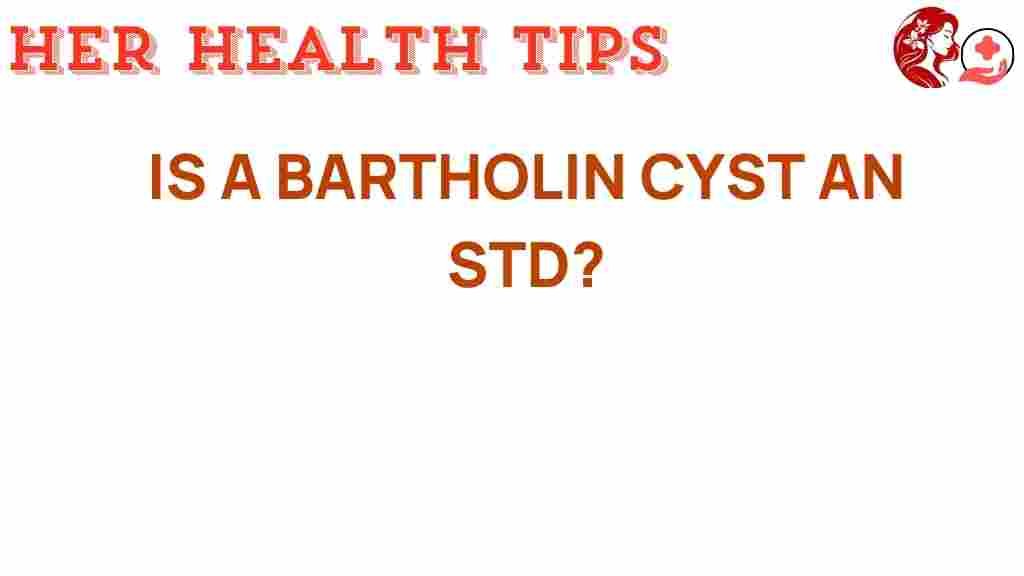Unveiling the Truth: Is a Bartholin Cyst an STD?
When it comes to women’s health, understanding various gynecological conditions is crucial. One common concern many women face is the Bartholin cyst. However, there is often confusion surrounding its classification and whether it can be considered a sexually transmitted disease (STD). In this article, we will delve into what a Bartholin cyst is, its symptoms, prevention, diagnosis, treatment options, and its relationship with reproductive health. By the end, you will have a comprehensive understanding of this condition.
What is a Bartholin Cyst?
A Bartholin cyst is a fluid-filled sac that forms when the Bartholin glands, located on either side of the vaginal opening, become blocked. These glands are responsible for producing lubrication during sexual arousal. When the duct of a Bartholin gland is obstructed, fluid accumulates, leading to the formation of a cyst. It’s important to note that a Bartholin cyst is not an STD, but understanding its causes and implications on women’s health is essential.
Causes of Bartholin Cysts
Several factors can contribute to the development of a Bartholin cyst, including:
- Infection: Bacterial infections, including sexually transmitted infections like gonorrhea or chlamydia, can lead to inflammation and blockage of the glands.
- Trauma: Injury to the vaginal area can cause the glands to become blocked.
- Hormonal changes: Hormonal fluctuations during menstruation or pregnancy can also affect gland function.
Bartholin Cyst Symptoms
Most Bartholin cysts do not cause any noticeable symptoms and may go unnoticed. However, when symptoms do occur, they can include:
- Swelling: A noticeable lump near the vaginal opening.
- Pain: Discomfort or pain during intercourse or while sitting.
- Infection signs: If the cyst becomes infected, symptoms may include redness, warmth, and pus drainage.
Distinguishing Bartholin Cysts from STDs
It’s essential to recognize that while some infections can lead to the formation of a Bartholin cyst, the cyst itself is not an STD. STDs are typically characterized by specific pathogens that cause infection, whereas a Bartholin cyst is a physical obstruction that may or may not be linked to an infection. Understanding this distinction is crucial for effective diagnosis and treatment.
Diagnosis of a Bartholin Cyst
Diagnosing a Bartholin cyst typically involves a physical examination by a healthcare provider. The doctor will:
- Perform a pelvic exam to check for swelling or tenderness.
- Ask about your medical history and any symptoms you may be experiencing.
- In some cases, a sample may be taken for laboratory testing to rule out infections.
Treatment Options for Bartholin Cysts
If treatment is necessary, options may include:
1. Watchful Waiting
In many cases, if the cyst is small and not causing any symptoms, the best approach may be to monitor it over time. Many cysts resolve on their own.
2. Warm Compresses
Applying warm compresses to the affected area can help alleviate discomfort and promote drainage if the cyst is infected.
3. Medical Intervention
If a Bartholin cyst becomes large or painful, a healthcare provider may recommend:
- Drainage: A simple procedure to drain the cyst fluid.
- Word Catheter: In some cases, a healthcare provider may insert a small catheter into the cyst cavity to keep it open and allow it to drain.
- Surgical Options: If cysts recur frequently, surgical removal of the glands may be considered.
Prevention of Bartholin Cysts
While not all Bartholin cysts can be prevented, there are steps women can take to reduce the risk of developing them:
- Practice Safe Sex: Use condoms to reduce the risk of STDs that can lead to infections.
- Maintain Good Hygiene: Regularly clean the genital area and avoid irritants.
- Regular Gynecological Check-ups: Routine exams can help catch issues early.
Bartholin Cyst and Reproductive Health
Understanding the relationship between Bartholin cysts and reproductive health is essential for women. While Bartholin cysts are generally not serious, they can affect sexual health and comfort. If you experience symptoms, it’s important to consult a healthcare provider to discuss your concerns and explore treatment options.
When to Seek Medical Attention
If you notice any of the following symptoms, it’s crucial to seek medical attention:
- A significant increase in size of the cyst.
- Pain that is worsening or persists.
- Signs of infection, such as fever or pus drainage.
Troubleshooting Tips
If you suspect you have a Bartholin cyst, consider the following tips:
- Keep a symptom diary: Note any changes in size, pain levels, or other symptoms.
- Practice self-care: Use warm compresses and maintain hygiene to manage discomfort.
- Consult with a gynecologist: Regular check-ups can help address concerns and provide peace of mind.
Conclusion
In summary, a Bartholin cyst is a common gynecological condition that is often misunderstood. While it can be associated with infections, it is not classified as an STD. Understanding the symptoms, diagnosis, and treatment options available can empower women to take charge of their reproductive health. If you have concerns about a Bartholin cyst or any aspect of your gynecological health, do not hesitate to reach out to a healthcare provider for guidance.
For more information on women’s health and gynecological conditions, visit this resource. Remember, staying informed is a key step in maintaining your reproductive health!
This article is in the category Reproductive and created by HerHealthTips Team
